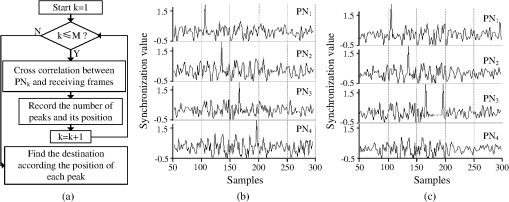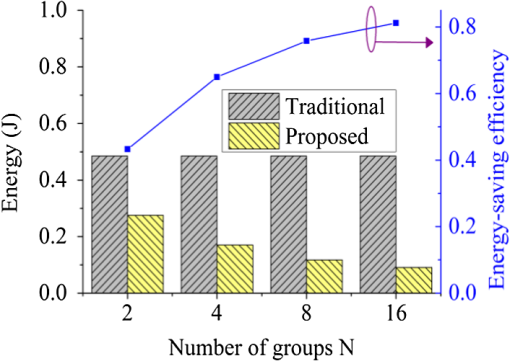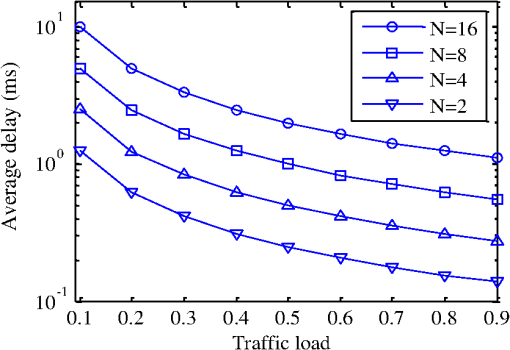|
|
1.IntroductionWith the emergence of bandwidth-intensive applications, such as high-definition television, cloud computing, big data services, and so on, the demands for large capacity in next generation passive optical networks (NG-PONs) are increasing continuously.1 Besides, other requirements such as high customer fan-out, elastic bandwidth allocation, and high-energy efficiency are also desired. Orthogonal frequency division multiplexing (OFDM) technique features flexible bandwidth allocation and capability of supporting a large number of subscribers with high bit rates, which is a potential solution for NG-PONs.2–4 However, in the practical PON system, with the increase of subscribers, the energy consumed by optical network units (ONUs) has already taken up about 60% of the total energy consumption of PONs today.5 In a OFDMA-PON system, the average user rate is , which only accounts for of the downstream line-rate.6 Nevertheless, in order to extract the user data, each ONU should demodulate the whole downlink data at the line rate. Thus, most components within an ONU have to be operated at the high-speed mode. For instance, in the downstream transmission, analog-to-digital convertor (ADC) needs to operate at least with a 16-quadrature amplitude modulation (QAM) format. In such a case, the high-speed ADC almost dominates the power consumption of an ONU. Besides, the digital signal processing (DSP) module following the ADC also occupies a large percentage of the energy consumptions due to the complex electrical calculations.7,8 To deal with the high energy consumption problem, Kimura et al.9,10 introduced a dynamic signal-to-noise ratio management scheme, where calculation precision of the fast Fourier transform (FFT) and inverse FFT (IFFT) is controlled to minimize energy consumptions.9,10 The scheme only considered the power of DSP while ignoring the energy-intensive DAC/ADC. Kanonakis and Tomkos11 have proposed a framework to adjust optical line terminal (OLT)/ONU DSP modules according to real traffic flows.11 We have demonstrated an energy-efficient ONU receiver based on selective sampling.12 The proposed receiver is specially designed for OFDMA-PON since the energy-intensive component ADC is essential to demodulate the user data. 256 synchronization patterns generated by four orthogonal pseudorandom (PN) sequences are used to identify the destination of downlink frames. Only the ONU which coincides with the identified destination keeps working, while others are switched to standby mode until the timer expires. In this article, PN sequence design and detailed destination identification procedure are introduced. We also investigate the trade-off between energy saving and downlink packet delay by simulation. In order to decrease the packet delay, some ONUs are formed to a group to share a common destination. In this case, multiple ONUs’ data can be transmitted in one downlink frame simultaneously while only one ONU’s data can be transmitted in Ref. 12. The results indicate that under limited delay conditions, energy can be saved compared with traditional receiving method in an OFDMA-PON system with 512 ONUs. 2.Energy Saving Principle with Selective Sampling ReceiverFigure 1 shows the downstream operation with our proposed ONU receiver in OFDMA-PON. The proposed selective sampling receiver consists of a PIN/APD, two stages of amplifier, an ADC, a DSP module for the FFT and demodulation, and so on. In addition, a timer is added to power the on/off state of the ADC with the help of a synchronization module. The synchronization is based on the special designed header, which is shown in Fig. 1. There are orthogonal PN sequences in the header, which means that totally different destinations can be identified by varying the arrangement of PN sequences. Note that one PN sequence can be repeated times to achieve a synchronization pattern since all the PN sequences are orthogonal to each other. Through this PN designed method, we can obtain lots of orthogonal PN sequences. So, each ONU can be assigned a particular synchronization pattern. Fig. 1Orthogonal frequency division multiplexing access passive optical network downstream operation with our proposed selective sampling receiver. TIA: trans-impedance amplifier; LA: linear amplifier. 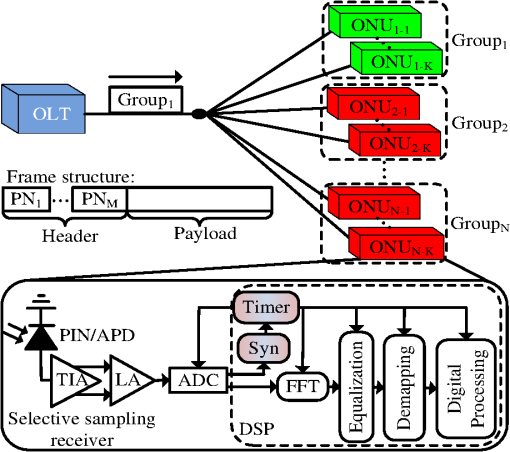 Then the energy saving principle with our proposed selective sampling receiver is illustrated as follows. The OFDM frame has a fixed length of 125 μm and consists of a payload and a header. Based on the special designed header, the destination of downstream frames can be identified. Only when the identified destination corresponds to that of the ONU does the ADC within the ONU continues to sample the analog input signal as usual. Otherwise, it switches to the standby mode to save energy until the timer expires. As shown in Fig. 1, there are groups in OFDMA-PON and ONUs within a group sharing a common destination. When an OFDM frame destined for is broadcasted to all ONUs, only ONUs within (green) keep working while others (red) are in the standby mode to save energy. 3.Experimental Setup and ResultsTo verify the feasibility of the proposed selective sampling receiver, we set up an experiment as shown in Fig. 2. In the OLT, the original data for two ONUs ( and ) in different groups are mapped through 16 QAM modulation format and then transferred to the time domain signals by 512 points IFFT. A cyclic prefix of 32 samples is used to eliminate inter-symbol interference. The Hermitian symmetry is applied to generate the real-valued OFDM signal. In the experiment, we use PN sequence to perform synchronization due to its good property of autocorrelation and high-synchronization accuracy.13 4 PN sequences (, , , and )are adopted and two headers ( and ) for and are attached to the frame head, respectively. Then, the OFDM data generated by MATLAB® are downloaded to the Tektronix AWG 7122C (Beaverton, Oregon), with sampling rate and 8-bit resolution. The bandwidth is 2.5 GHz and the raw bit rate is . The analog signal is applied to a directly modulated distributed feedback laser (DFB) laser biased at 60 mA. The output power of the DFB laser is . After 25-km single-mode fiber transmission, the digital sampling oscilloscope with is used to capture the signal for further DSP processing. The following operation includes synchronization, FFT, equalization, and so on. The sensitivity of the received signal is at the bit error rate (BER) of . Fig. 2Experimental setup of the proposed selective sampling receiver: insets (i) and (ii) are the transmitted and received waveforms, respectively; inset (iii) is the constellation. 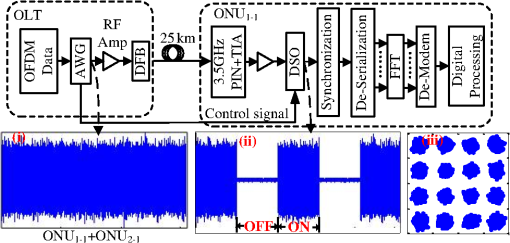 In the experiment, since there is no real-time ONU receiver in our lab, we use AWG to switch on/off the ADC instead of the synchronization module. The transmitted waveform including two ONUs’ data is shown in the inset (i) of Fig. 2. The received waveform of under the condition of selective sampling is discontinuous, as shown in the inset (ii) of Fig. 2. The received samples for can be demodulated correctly and the constellation is depicted in the inset (iii) of Fig. 2, which shows the feasibility of the proposed selective sampling ONU receiver. Figure 3 gives the destination identification procedure and the results according to the different headers in the experiment. In the destination identification procedure shown in Fig. 3(a), cross-correlation is first performed between the receiving frame and (, 2, 3, 4). Then, the synchronization profile corresponding to each (, 2, 3, 4) is obtained in Figs. 3(b) and 3(c). According to the synchronization profile, the number of synchronization peaks and their corresponding positions are recorded for further destination identification. For example in Fig. 3(b), only one peak appears in each PN sequence and its position is different, meaning that the receiving frame contains the PN sequence . That is, the destination of this frame is since the detected PN sequences are consistent with the frame header of in the experiment. Similarly, in Fig. 3(c), two peaks appear in but no peaks appear in , implying that the PN sequence is included in the frame. It means that the destination of the receiving frame in Fig. 1(c) is . From the results in Figs. 3(b) and 3(c), it can be clearly seen that the destination can be identified clearly. During the synchronization, if one of the synchronization peaks is missed, the start position of symbols can still be obtained with the help of other synchronization peaks. Nevertheless, the receiver would make a mistake about the destination of this frame. Then, the control signal used to switch on/off ADC is generated according the destination of the receiving frame. For , as long as the destination of the receiving frame is other ONUs, the ADC switches to standby mode until the timer expires. Otherwise, the receiving frame is being sampled and demodulated as usual. 4.Energy-Saving and Other AnalysisDuring the selective sampling procedure, the more time the ADC stays in standby mode, the more energy can be saved. However, the time spent on standby mode is significantly affected by the synchronization speed, because only after the destination of the receiving frame is identified, the ADC might switch to standby mode. Thus, it is desirable to reduce the length and the number of orthogonal PN sequences to accelerate synchronization. In fact, the number of PN sequences generated by primitive polynomials is limited, which is shown in Table 1. Moreover, only different destinations can be identified through the arrangement of orthogonal PN sequences. In the experiment, the coefficient of primitive polynomial is set to 5 and the length of PN sequence is 31 bits. Although the PN sequences added to the data stream increase the redundancy of the transmission, it has little impact on transmission efficiency because PN sequences are a small fraction of the OFDM frame. Table 1Pseudorandom (PN) sequence design.
In the energy analysis, we consider an OFDMA-PON system with 512 ONUs. When OLT broadcasts one OFDM frame, the energy consumption of all ONUs using a conventional receiving method is denoted as where is the number of groups and is the number of ONUs within a group. is the length of an OFDM frame, which is 125 μs in this article. The power of APD/TIA, LA, ADC, FFT, and digital processing is denoted as , , , and respectively, which has already been investigated in Ref. 11. The energy consumption of all ONUs using the selective sampling ONU receivers can be calculated asis the time of synchronization and the ratio is set to 0.1. This ratio is related with the synchronization time and the OFDM frame length. The synchronization time in traditional OFDM communication is on the order of microseconds.14,15 About the OFDM frame length, as the frame format for OFDM-PON has not been standardized yet, a 125-μs frame length is considered in our experiment, which is in accordance with gigabit-capable passive optical network (GPON) standards. The energy-saving efficiency is also defined as follows The energy consumption and energy-saving efficiency with different numbers of groups is shown in Fig. 4. We can see that an obvious reduction of energy consumption is obtained using proposed selective sampling receivers. Besides, the energy-saving efficiency increases with the number of groups , since more ONUs can stay in standby mode with the increase of groups. During the energy-efficient receiving method, only packets having a common destination can constitute a complete OFDM frame to be transmitted, therefore resulting in the packet delay. We study the delay performance for Poisson traffic using simulation. Consider a 10G OFDMA-PON system supporting 512 ONUs. Figure 5 shows that the average delay first decreases with the increase of the traffic load. This is because with the increase of the traffic load, the packets sharing a common destination increase, and the time spent on constituting an OFDM frame decreases, therefore resulting in the decrease of the average delay. We can also see that the delay increases when the number of groups increases. The increasing results in the decrease of ONUs within a group owing to the fixed number of ONUs in the system, therefore resulting in the increase of average delay. 5.ConclusionIn this article, we proposed a physical-layer energy-efficient receiving method using a selective sampling receiver in OFDMA-PONs. The receiver only samples at the time when the incoming frame targets to the ONU and stays in standby during the rest of the time. An experiment is performed to verify its feasibility. The design of PN sequence and delay performance are also analyzed. The results show that using our proposed selective sampling receivers, energy can be saved when adopting four groups in OFDMA-PON with 512 ONUs. AcknowledgmentsThe work was jointly supported by the National Nature Science Fund of China (No. 61271216, No. 61221001, No. 61090393, and No. 60972032), the National “973” Project of China (No. 2010CB328205, No. 2010CB328204, and No. 2012CB315602), China Postdoctoral Science Foundation (No. 2013M540361) and the National “863” Hi-tech Project of China. ReferencesJ. Kaniet al.,
“Next-generation PON—Part I: Technology roadmap and general requirements,”
IEEE Commun. Mag., 47
(11), 43
–49
(2009). http://dx.doi.org/10.1109/MCOM.2009.5307465 ICOMD9 0163-6804 Google Scholar
J. M. Tanget al.,
“Real-time optical OFDM transceivers for PON applications,”
in Proc. Optical Fiber Communications Conf.,
(2011). Google Scholar
N. Cvijetic,
“OFDM for next-generation optical access networks,”
J. Lightwave Technol., 30
(4), 384
–398
(2012). http://dx.doi.org/10.1109/JLT.2011.2166375 JLTEDG 0733-8724 Google Scholar
M. F. Tiagoet al.,
“OFDM-WDM LR-PON with ultra-bendable fiber for last-mile distribution of quintuple-play service,”
Chin. Opt. Lett., 11 030606
(2013). http://dx.doi.org/10.3788/COL COLHBT 1671-7694 Google Scholar
J. Kani,
“Power saving techniques for optical access,”
in Optical Fiber Communication Conf.,
(2012). Google Scholar
C. V. Praetet al.,
“Demonstration of low-power bit-interleaving TDM PON,”
Opt. Express, 20
(26), B7
–B14
(2012). http://dx.doi.org/10.1364/OE.20.0000B7 OPEXFF 1094-4087 Google Scholar
P. A. Milderet al.,
“Design and simulation of optical OFDM transceiver ASICs,”
Opt. Express, 19
(26), B337
–B342
(2011). http://dx.doi.org/10.1364/OE.19.00B337 OPEXFF 1094-4087 Google Scholar
R. Bouzianeet al.,
“Design studies for an ASIC implementation of an optical OFDM transceiver,”
in Proc. European Conf. Optical Communication,
(2010). Google Scholar
H. Kimuraet al.,
“Numerical analysis of dynamic SNR management by controlling DSP calculation precision for energy-efficient OFDM-PON,”
IEEE Photonics Technol. Lett., 24
(23), 2132
–2135
(2012). http://dx.doi.org/10.1109/LPT.2012.2222878 IPTLEL 1041-1135 Google Scholar
H. Kimuraet al.,
“Dynamic SNR management using variable precision DSP for energy efficient OFDM-PON,”
in Opto-Electronics and Communication Conf.,
(2012). Google Scholar
K. KanonakisI. Tomkos,
“Energy-efficient OFDMA-PON exploiting modular OLT/ONU digital signal processing,”
in Proc. Optical Fiber Communication Conf.,
(2013). Google Scholar
J. Liet al.,
“Energy-efficient selective sampling receiver for OFDMA-PON,”
in Asia Communication and Photonics Conf.,
(2013). Google Scholar
W. Chenget al.,
“A joint time and frequency synchronization method based on PN sequences for OFDM,”
in IEEE Int. Conf. on Computer Science and Information Technology,
(2009). Google Scholar
X. MeiZ. DingL. Pan,
“FPGA implementation of frame synchronization in burst OFDM communication based on IEEE802.11a,”
in Int. Conf. on Wireless Communications, Networking and Mobile Computing,
(2012). Google Scholar
Y. Xiaoet al.,
“Implementation of symbol timing synchronization for MB-OFDM UWB systems on FPGA,”
in IEEE Int. Conf. on Signal Processing, Communications and Computing (ICSPCC),
(2011). Google Scholar
BiographyJun Li is a PhD candidate at Shanghai Jiaotong University, Shanghai, China. He received his BS degree in electronic information engineering at XIDIAN University in 2010. After graduation, he joined the State Key Laboratory of Advanced Optical Communication System and Networks. His current research interests include optical access networks, OFDM, and energy efficiency. Hao He is an assistant professor of electrical engineering at Shanghai Jiao Tong University, China. He received his BS and MS degrees in physics from University of Science and Technology of China in 1999 and in 2002, respectively. Since 2003, he has joined State Key Laboratory of Advanced Optical Communication Systems and Networks of Shanghai Jiao Tong University. His research interests include ultrafast analog-to-digital conversion, optical packet switch network and optical access network. Meihua Bi is a PhD candidate of the State Key Laboratory of Advanced Optical Communication Systems and Networks, Shanghai Jiao Tong University, China. Currently, her research involves the resource scheduling algorithm and experimental exploration in the areas of high-speed communications systems and optical networks with specialization in advanced signal modulation formats and techniques such as optical orthogonal frequency-division multiplexing (OFDM) for passive optical networks (PONs), (ultra dense) wavelength division multiplexing passive optical network (UDWDM-PON), and WDM-PON. Weisheng Hu received his BS, MS, and PhD degrees from Tsinghua University, Beijing University of Science and Technology, and Nanjing University in 1986, 1989, and 1997, respectively. He joined Shanghai Jiao Tong University as a postdoctorate fellow from 1997 to 1998, and as a professor from 1999. He serves for four journals and 12 conferences, including IEEE JLT, OFC. His interests are on the optical transport network with GMPLS and optical packet switching. |

